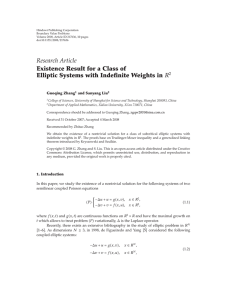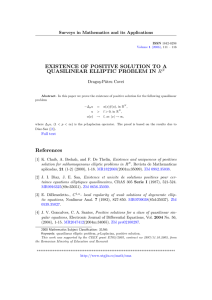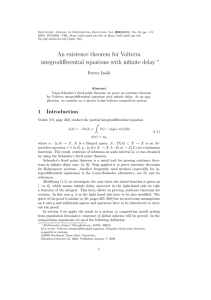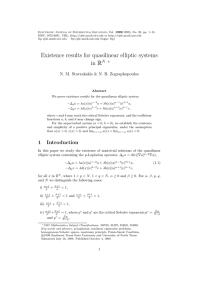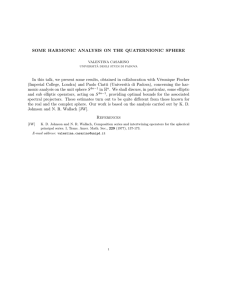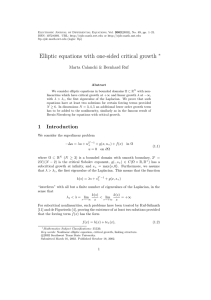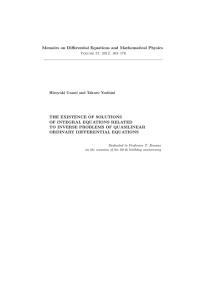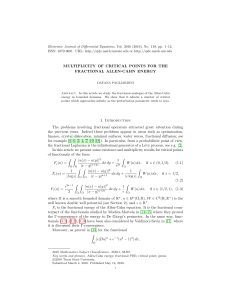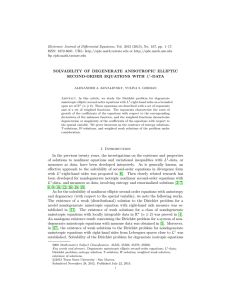Electronic Journal of Differential Equations, Vol. 2005(2005), No. 107, pp.... ISSN: 1072-6691. URL: or
advertisement
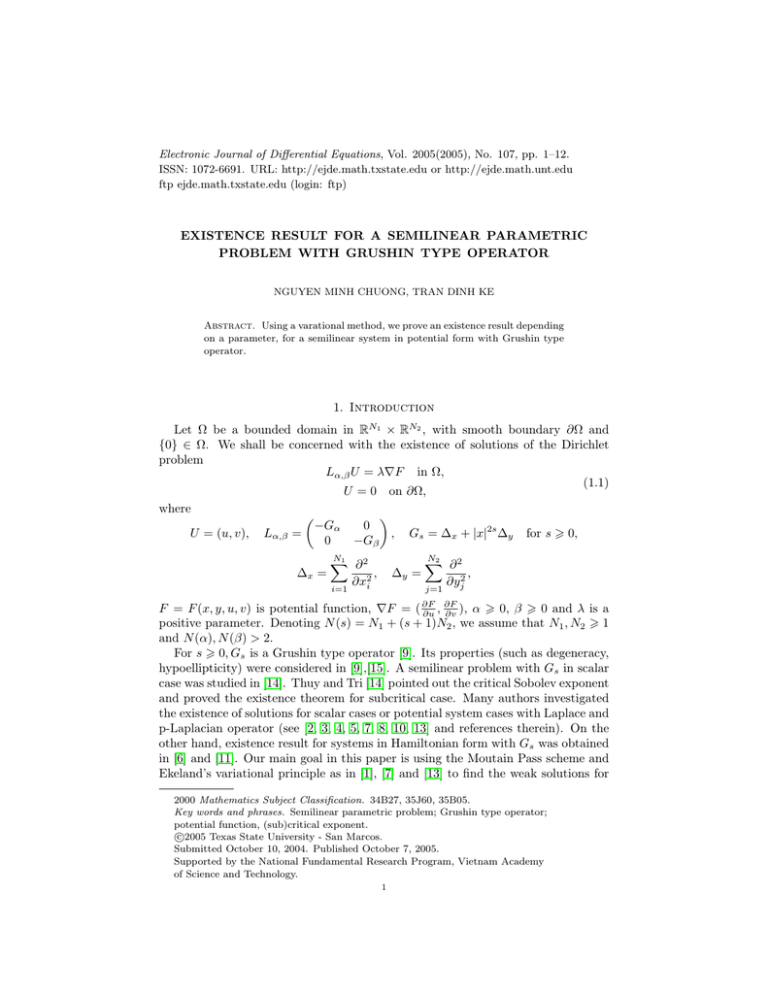
Electronic Journal of Differential Equations, Vol. 2005(2005), No. 107, pp. 1–12.
ISSN: 1072-6691. URL: http://ejde.math.txstate.edu or http://ejde.math.unt.edu
ftp ejde.math.txstate.edu (login: ftp)
EXISTENCE RESULT FOR A SEMILINEAR PARAMETRIC
PROBLEM WITH GRUSHIN TYPE OPERATOR
NGUYEN MINH CHUONG, TRAN DINH KE
Abstract. Using a varational method, we prove an existence result depending
on a parameter, for a semilinear system in potential form with Grushin type
operator.
1. Introduction
Let Ω be a bounded domain in RN1 × RN2 , with smooth boundary ∂Ω and
{0} ∈ Ω. We shall be concerned with the existence of solutions of the Dirichlet
problem
Lα,β U = λ∇F in Ω,
(1.1)
U = 0 on ∂Ω,
where
−Gα
0
U = (u, v), Lα,β =
, Gs = ∆x + |x|2s ∆y for s > 0,
0
−Gβ
N1
X
∂2
,
∆x =
∂x2i
i=1
N2
X
∂2
∆y =
,
∂yj2
j=1
∂F
F = F (x, y, u, v) is potential function, ∇F = ( ∂F
∂u , ∂v ), α > 0, β > 0 and λ is a
positive parameter. Denoting N (s) = N1 + (s + 1)N2 , we assume that N1 , N2 > 1
and N (α), N (β) > 2.
For s > 0, Gs is a Grushin type operator [9]. Its properties (such as degeneracy,
hypoellipticity) were considered in [9],[15]. A semilinear problem with Gs in scalar
case was studied in [14]. Thuy and Tri [14] pointed out the critical Sobolev exponent
and proved the existence theorem for subcritical case. Many authors investigated
the existence of solutions for scalar cases or potential system cases with Laplace and
p-Laplacian operator (see [2, 3, 4, 5, 7, 8, 10, 13] and references therein). On the
other hand, existence result for systems in Hamiltonian form with Gs was obtained
in [6] and [11]. Our main goal in this paper is using the Moutain Pass scheme and
Ekeland’s variational principle as in [1], [7] and [13] to find the weak solutions for
2000 Mathematics Subject Classification. 34B27, 35J60, 35B05.
Key words and phrases. Semilinear parametric problem; Grushin type operator;
potential function, (sub)critical exponent.
c
2005
Texas State University - San Marcos.
Submitted October 10, 2004. Published October 7, 2005.
Supported by the National Fundamental Research Program, Vietnam Academy
of Science and Technology.
1
2
N. M. CHUONG, T. D. KE
EJDE-2005/107
system (1.1) in the suitable Sobolev space when λ ∈ (0, λ∗ ) and observe on the
behaviour of that solutions as λ → 0. In particular, we consider the system (1.1)
with some classes of homogeneous and nonhomogeneous nonlinearities. To state
our main result, we need some definitions and notations.
1.1. Definition 1. By S1p (Ω), 1 6 p < +∞, we denote the set of all pair (u, v) ∈
∂u
∂v
∂u
∂v
Lp (Ω) × Lp (Ω) such that ∂x
, ∂x
, |x|α ∂y
, |x|β ∂y
∈ Lp (Ω) for all i = 1, . . . , N1 ,
i
i
j
j
and j = 1, . . . , N2 .
For the norm in S1p (Ω), we take
hZ
i1/p
p
k(u, v)kS1 (Ω) =
(|u|p +|∇x u|p +|x|pα |∇y u|p +|v|p +|∇x v|p +|x|pβ |∇y v|p )dxdy
Ω
where
∇x = (
∂
∂
∂
∂
), ∇y = (
).
,...,
,...,
∂x1
∂xN1
∂y1
∂yN2
For p = 2, the inner product in S12 (Ω) is defined by
h(u, v), (ϕ, ψ)i
Z
= (uϕ + ∇x u∇x ϕ + |x|2α ∇y u∇y ϕ + vψ + ∇x v∇x ψ + |x|2β ∇y v∇y ψ)dx dy.
Ω
p
The space S1,0
(Ω) is defined as closure of C01 (Ω) × C01 (Ω) in space S1p (Ω). By
p
standard arguments, one can prove that S1p (Ω) and S1,0
(Ω) are Banach spaces,
2
2
S1 (Ω) and S1,0 (Ω) are Hilbert spaces.
The following Sobolev embedding inequality was proved in [14].
hZ
i1/2
Z
1/q
6C
(|∇x u|2 + |x|2s |∇y u|2 )dx dy
,
(1.2)
|u|q dx dy
Ω
Ω
where q =
2N (s)
N (s)−2
− τ, C > 0, s > 0 and N (s) = N1 + (s + 1)N2 , provided small
N (s)+2
positive number τ . Furthermore, the number N
(s)−2 is critical Sobolev exponent
for the embedding in (1.2).
Denoting by
Lp,q (Ω) = {(u, v) : u ∈ Lp (Ω), v ∈ Lq (Ω)},
and endowing this space with the norm
hZ
i1/p h Z
i1/q
p
k(u, v)kLp,q (Ω) =
|u| dx dy
+
|v|q dx dy
,
Ω
Ω
2N (α)
2N (β)
2
we have the conclusion in view of (1.2) that S1,0
(Ω) ⊂ L N (α)−2 −τ1 , N (β)−2 −τ2 (Ω)
and this embedding is a compact mapping for all small positive numbers τ1 and τ2
(see [14]).
2
1.2. Definition 2. A pair (u, v) ∈ S1,0
(Ω) is called a weak solution of system (1.1)
if
Z
Z
∂F
ϕdx dy,
(∇x u∇x ϕ + |x|2α ∇y u∇y ϕ)dx dy = λ
∂u
ZΩ
ZΩ
(1.3)
∂F
2β
(∇x v∇x ψ + |x| ∇y v∇y ψ)dx dy = λ
ψdx dy
Ω
Ω ∂v
for every ϕ, ψ ∈ C0∞ (Ω).
EJDE-2005/107
EXISTENCE RESULT
3
Since the system (1.1) is in the gradient form, we intend to get its solutions as
the critical points of the functional
Z
1
Iλ (u, v) =
(|∇x u|2 + |x|2α |∇y u|2 + |∇x v|2 + |x|2β |∇y v|2 )dx dy
2 Ω
Z
(1.4)
−λ
F (x, y, u, v)dx dy,
Ω
2
defined on reflexive Banach space S1,0
(Ω) with Fréchet derivative given by
Z
hIλ0 (u, v), (ϕ, ψ)i = (∇x u∇x ϕ + |x|2α ∇y u∇y ϕ + ∇x v∇x ψ + |x|2β ∇y v∇y ψ)dx dy
Ω
Z
∂F
∂F
ϕ+
ψ)dx dy.
−λ (
∂u
∂v
Ω
(1.5)
∂F
and
g
=
be
two
Carathéodory
functions
satisfying
the
following
Let f = ∂F
∂u
∂v
conditions:
(H1) There exist positive constants Ci , for i = 1, . . . , 6 such that
|f (x, y, s, t)| 6 C1 + C2 |s|r1 + C3 |t|r2 ,
|g(x, y, s, t)| 6 C4 + C5 |s|r3 + C6 |t|r4
(1.6)
for a.e. (x, y) ∈ Ω and for all s, t ∈ R, where
0 < r 1 , r2 <
N (α) + 2
;
N (α) − 2
0 < r3 , r4 <
N (β) + 2
.
N (β) − 2
(1.7)
(H2) F (x, y, 0, 0) = 0 and there are two positive constants µ > 2 and M > 0
such that
0 < µF (x, y, u, v) 6 uf (x, y, u, v) + vg(x, y, u, v)
(1.8)
for a.e. (x, y) ∈ Ω and for all u, v ∈ R satisfying |u|, |v| > M > 0.
(H3) For a.e. (x, y) ∈ Ω,
lim
|u|+|v|→∞
F (x, y, u, v)
= +∞.
|u|2 + |v|2
(1.9)
The inequalities in (1.6) and (1.7) express the subcritical character of the system
(1.1) and guarantee the well-definiteness of the functional Iλ . It’s now to state our
main result.
Theorem 1.1. Under hypotheses (H1), (H2) and (H3), there exists a positive
constant λ∗ such that for any λ ∈ (0, λ∗ ), the functional Iλ has a nontrivial critical
2 (Ω) → +∞ as λ → 0.
point (uλ , vλ ) satisfying k(uλ , vλ )kS1,0
Our work is organized as follows. In section 2, we prove some lemmas to establish
the analysis framework for the proof of the main theorem in section 3. We shall
make a note that, the operator Lα,β in system (1.1) has some extensions preserved
our proofs. In the last section, we are interested in some cases of nonlinearity of
the system (1.1).
4
N. M. CHUONG, T. D. KE
EJDE-2005/107
2. Preliminaries
We first recall standard definitions and notations. Let X be a reflexive Banach
space endowed with a norm k.k. Let h., .i denote the duality pairing between X
and its dual X ∗ . We denote the weak convergence in X by “*” and the strong
convergence by “→”.
Let I ∈ C 1 (X, R). We say I satisfies the Palais-Smale condition, denoted by
(P S) condition, if every Palais-Smale sequence (a sequence {xn } ⊂ X such that
0
{I(xn )} is bounded and I (xn ) → 0 in dual space X ∗ ) is relatively compact.
Putting
Z
1
Φ(u, v) =
(|∇x u|2 + |x|2α |∇y u|2 + |∇x v|2 + |x|2β |∇y v|2 )dx dy,
2 Ω
Z
F (x, y, u, v)dx dy,
Ψ(u, v) =
Ω
we can write
Iλ (u, v) = Φ(u, v) − λΨ(u, v).
(2.1)
Lemma 2.1. Suppose f and g are continuous functions satisfying (H2). Then
every Palais-Smale sequence of Iλ is bounded.
Proof. Let {(un , vn )} be a Palais-Smale sequence of Iλ , that is,
Φ(un , vn ) − λΨ(un , vn ) → c
(2.2)
and
0
0
2 (Ω) ,
|hΦ (un , vn ), (ξ, η)i − λhΨ (un , vn ), (ξ, η)i| 6 n k(ξ, η)kS1,0
(2.3)
2
for all (ξ, η) ∈ S1,0
(Ω), where n → 0 as n → ∞. From (2.2), we have
µΦ(un , vn ) − λµΨ(un , vn ) 6 µc + 1.
(2.4)
Subtracting (2.3), with (ξ, η) = (un , vn ), yields
0
(µ − 2)Φ(un , vn ) − λ[µΨ(un , vn ) − hΨ (un , vn ), (un , vn )i]
2 (Ω) .
6 µc + 1 + n k(un , vn )kS1,0
(2.5)
Assumption (H2) ensures that
0
µΨ(un , vn ) − hΨ (un , vn ), (un , vn )i 6 0.
(2.6)
Therefore, (2.5) implies
µ−2
2 (Ω) 6 µc + 1.
k(un , vn )k2S 2 (Ω) − n k(un , vn )kS1,0
1,0
2
2
Consequently, {(un , vn )} is bounded in S1,0
(Ω).
2
(Ω). Then
Lemma 2.2. Let assumption (H1) hold and (un , vn ) * (u, v) in S1,0
0
lim hΨ (un , vn ), (un − u, vn − v)i = 0.
n→∞
Proof. It suffices to prove that
Z
lim
[f (x, y, un , vn )(un − u) + g(x, y, un , vn )(vn − v)]dx dy = 0.
n→∞
Ω
(2.7)
EJDE-2005/107
EXISTENCE RESULT
5
We first show that there exists constant M1 > 0 such that
Z
2N (α)
|f (x, y, un , vn )|p dx dy < M1 , for p =
+ τ,
N
(α) + 2
Ω
(2.8)
if τ is positive and sufficiently small. By assumption (H1) and the fact that
(α)
pr1 , pr2 6 N2N
(α)−2 − δ(τ ), we have
Z
Z
|f (x, y, un , vn )|p dx dy 6 (C1 + C2 |un |pr1 + C3 |vn |pr2 )dx dy
Ω
Ω
2N (α)
6C(1 + k(un , vn )kSN2(α)−2
(Ω)
−δ(τ )
),
1,0
where C > 0, δ(τ ) is positive and δ(τ ) → 0 as τ → 0. Since {(un , vn )} is a bounded
sequence, (2.8) follows. Similarly,
Z
2N (β)
|g(x, y, un , vn )|q dx dy < M2 , for q =
+ τ,
(2.9)
N
(β) + 2
Ω
where M2 > 0, τ is positive and sufficiently small.
We are now in a position to prove (2.7). Let p0 be the conjugate exponent of p,
using Hölder inequality, we have
Z h
i
|f (x, y, un , vn )(un − u)| + |g(x, y, un , vn )(vn − v)| dx dy
Ω
1/p Z
1/p0
Z
0
p
|un − u|p dx dy
|f (x, y, un , vn )| dx dy
6
Ω
Ω
Z
1/q Z
1/q0
0
q
+
|g(x, y, un , vn )| dx dy
|un − u|q dx dy
Ω
1/p
Ω
1/q
6 M1 kun − ukLp0 (Ω) + M2 kvn − vkLq0 (Ω)
6 M k(un , vn ) − (u, v)kLp0 ,q0 (Ω)
where M > 0 and
p0 =
δ1 (τ ) > 0
and δ1 (τ ) → 0
q0 =
δ2 (τ ) > 0
2N (α) + τ [N (α) + 2]
2N (α)
=
− δ1 (τ ),
N (α) − 2 + τ [N (α) + 2]
N (α) − 2
as
τ → 0,
2N (β) + τ [N (β) + 2]
2N (β)
=
− δ2 (τ ),
N (β) − 2 + τ [N (β) + 2]
N (β) − 2
and δ2 (τ ) → 0
as τ → 0.
2N (α)
2N (β)
2
The compactness of the embedding S1,0
(Ω) ⊂ L N (α)−2 −δ1 (τ ), N (β)−2 −δ2 (τ ) (Ω) implies that there exists a subsequence, denoted also by {(un , vn )}, such that
k(un , vn ) − (u, v)kLp0 ,q0 (Ω) → 0
as
n → ∞.
The proof is complete.
2
Lemma 2.3. If (un , vn ) * (u, v) in S1,0
(Ω) and
lim hΦ0 (un , vn ), (un − u, vn − v)i = 0,
n→∞
2
then (un , vn ) → (u, v) in S1,0
(Ω).
6
N. M. CHUONG, T. D. KE
EJDE-2005/107
Proof. Let {(un , vn )} converge weakly to (u, v). Denoting
Z
Jn = [∇x u∇x (un − u) + |x|2α ∇y u∇y (un − u)]dx dy
Ω
Z
+ [∇x v∇x (vn − v) + |x|2β ∇y v∇y (vn − v)]dx dy,
Ω
we have limn→∞ Jn = 0. On the other hand,
hΦ0 (un , vn ), (un − u, vn − v)i
Z
= [|∇x (un − u)|2 + |x|2α |∇y (un − u)|2 ]dx dy
Ω
Z
+ [|∇x (vn − v)|2 + |x|2β |∇y (vn − v)|2 ]dx dy + Jn .
Ω
2 (Ω) → 0 as n → ∞. The conclusion of Lemma 2.3 is
Hence k(un − u, vn − v)kS1,0
proved.
Lemma 2.4. Let assumptions (H1) and (H2) hold. Then Iλ satisfies the (PS)
condition.
Proof. Suppose that {(un , vn )} is a Palais-Smale sequence of Iλ . Lemma 2.1 ensures
2
that {(un , vn )} is bounded in S1,0
(Ω). Then, there exists a subsequence, denoted
2
also {(un , vn )} converging weakly to (u, v) in S1,0
(Ω). By the conclusion of Lemma
2.2,
lim hΨ0 (un , vn ), (un − u, vn − v) = 0,
n→∞
and the fact that
hIλ0 (un , vn ), (un − u, vn − v)i
= hΦ0 (un , vn ), (un − u, vn − v)i − λhΨ0 (un , vn ), (un − u, vn − v)i,
we obtain
lim Φ0 (un , vn ), (un − u, vn − v)i = 0.
n→∞
Lemma 2.3 allows us to conclude that {(un , vn )} converge strongly to (u, v) in
2
S1,0
(Ω). Hence, the functional Iλ satisfies the (PS) condition.
3. Proof of the Existence Result
Lemma 3.1. Assume that the hypotheses of Theorem 1.1 hold. Then there exist
positive numbers ηλ and ρλ such that ηλ → +∞ as λ → 0 and,
Iλ (u, v) > ηλ
2
2 (Ω) > ρλ .
for all (u, v) ∈ S1,0
(Ω) satisfying k(u, v)kS1,0
2
Moreover, Iλ (tu, tv) → −∞ as t → +∞ for some (u, v) ∈ S1,0
(Ω)\{(0, 0)}.
Proof. Let
2N (β)
2N (α)
+ τ, q =
+ τ.
N (α) + 2
N (β) + 2
Using the same arguments in the proof of Lemma 2.2, we obtain
Z
2N (α)
−γ1 (τ )
|f (x, y, u, v)|p dx dy 6 Cp (1 + k(u, v)kSN2(α)−2
),
1,0 (Ω)
ZΩ
2N (β)
−γ2 (τ )
),
|g(x, y, u, v)|q dx dy 6 Cq (1 + k(u, v)kSN2(β)−2
(Ω)
p=
Ω
1,0
(3.1)
EJDE-2005/107
EXISTENCE RESULT
7
where γ1 (τ ), γ2 (τ ) are positive and γ1 (τ ), γ2 (τ ) → 0 as τ → 0. Now, from the
inequalities in (3.1), one can estimate
Z
F (x, y, u, v)dx dy
Ω
Z
6 C [uf (x, y, u, v) + vg(x, y, u, v)]dx dy
Ω
Z
1/p Z
1/p0
0
6C
|f (x, y, u, v)|p dx dy
|u|p dx dy
Ω
Ω
Z
1/q Z
1/q0
0
+C
|g(x, y, u, v)|q dx dy
|v|q dx dy
Ω
Ω
2N (α)
−γ1 (τ )
N (α)−2
2 (Ω)
S1,0
1/p
kukLp0 (Ω)
6C 1 + k(u, v)k
2N (β)
−γ2 (τ ) 1/q
kvkLq0 (Ω)
+ C 1 + k(u, v)kSN2(β)−2
(Ω)
1,0
i
h
2N (β)
2N (α)
−γ1 (τ ) 1/p
−γ2 (τ ) 1/q
+ 1 + k(u, v)kSN2(β)−2
6C 1 + k(u, v)kSN2(α)−2
(Ω)
(Ω)
1,0
1,0
× (kukLp0 (Ω) + kvkLq0 (Ω) ).
h
i
2N (α)
2N (β)
−γ1 (τ ) 1/p
−γ2 (τ ) 1/q
N (β)−2
2 (Ω) ,
6C 1 + k(u, v)kSN2(α)−2
+
1
+
k(u,
v)k
k(u, v)kS1,0
2
(Ω)
S (Ω)
1,0
1,0
for some positive constant C. Note that, the Young inequality gives
1
1
1 1
1 1
A p 6 + A, B q 6 + B for A, B > 0.
q
p
p q
From these facts, we have
Z
2N (α)
2N (β)
+1−γ1 (τ )
+1−γ2 (τ )
N (β)−2
∗
F (x, y, u, v)dx dy 6 C1∗ + C2∗ k(u, v)kSN2(α)−2
+
C
k(u,
v)k
,
3
(Ω)
S 2 (Ω)
1,0
Ω
for some
we get
C1∗ , C2∗ , C3∗
1,0
> 0. Using the last inequality and taking (2.1) into account,
1
Iλ (u, v) > k(u, v)k2S 2 (Ω)
1,0
2
2N (α)
−
λ[C1∗
+
+1−γ1 (τ )
C2∗ k(u, v)kSN2(α)−2
1,0 (Ω)
2N (β)
+
+1−γ2 (τ )
C3∗ k(u, v)kSN2(β)−2
].
1,0 (Ω)
(3.2)
−s
2
2 (Ω) = λ
(Ω) such that k(u, v)kS1,0
, with s satisfying
Choosing (u, v) ∈ S1,0
N (α) − 2 N (β) − 2 0 < s < s∗ = min
,
,
N (α) + 2 N (β) + 2
we have
Iλ (u, v) > λ−2s
h1
i
N (α)+2
N (β)+2
− C2∗ λ1−s N (α)−2 − C3∗ λ1−s N (β)−2 − λC1∗ .
2
Taking ρλ = λ−s , ηλ = 12 λ−2s , we conclude that Iλ (u, v) > ηλ if λ is sufficiently
2 (Ω) > ρλ .
small and k(u, v)kS1,0
Our task is now to show that Iλ (tu, tv) → −∞ as t → +∞, for some (u, v) ∈
2
S1,0
(Ω)\{(0, 0)}. It follows from (H3) that, given M > 0, there exists K(M ) > 0
such that
F (x, y, s, t) > M (s2 + t2 ),
for all s, t ∈ R satisfying |s| + |t| > K(M ).
8
N. M. CHUONG, T. D. KE
EJDE-2005/107
R
2
2 (Ω) = 1 and
Let (u, v) ∈ S1,0
(Ω) with k(u, v)kS1,0
(u2 + v 2 )dx dy = a. Then
Ω
Z
1
Iλ (tu, tv) = t2 − λ
F (x, y, tu, tv)dx dy
2
Ω
and
Z
Z
(u2 + v 2 )dx dy − b, (3.3)
F (x, y, tu, tv)dx dy > M t2
Ω
Ω∩{(x,y)∈Ω:|u|+|v|>
where b is a constant depending on a.
For t sufficient large,
Z
K(M )
Ω∩{(x,y)∈Ω:|u|+|v|> t }
K(M )
}
t
(u2 + v 2 )dx dy >
1
a.
2
From this and (3.3), we arrive at the conclusion
1
1
Iλ (tu, tv) 6 t2 − aλM t2 + b,
2
2
2
for t sufficient large. Choosing M = aλ leads to
1
Iλ (tu, tv) 6 b − t2 , for t sufficient large.
2
Hence, Iλ (tu, tv) → −∞ as t → +∞.
Proof of Theorem 1.1. By Lemma 2.4 and Lemma 3.1, we may apply the Mountain
Pass Theorem [12]. It follows that there exists λ∗ > 0 such that for all λ ∈ (0, λ∗ ),
the functional Iλ has a critical point (uλ , vλ ) satisfying Iλ (uλ , vλ ) > ηλ > 0 and
−s
2 (Ω) > ρλ = λ
k(uλ , vλ )kS1,0
→ +∞ as λ → 0.
Remark. (1) The operator Gs can be extended to the more complicated form
∆x + |x|2s1 ∆y + |x|2s2 ∆z ,
in the domain Ω ⊂ RN1 × RN2 × RN3 . Following [14], the critical exponent for this
case is
N1 + (s1 + 1)N2 + (s2 + 1)N3 + 2
.
N1 + (s1 + 1)N2 + (s2 + 1)N3 − 2
Generally, Gs has the form
m
X
∆ω0 +
|ω0 |2si ∆ωi ,
i=1
Qm
in the domain Ω = {(ω0 , ω1 , . . . , ωm )} ⊂ i=0 RNi . The associated critical exponent is given by
Pm
N0 + i=1 (si + 1)Ni + 2
Pm
.
N0 + i=1 (si + 1)Ni − 2
Putting ω = (ω0 , ω1 , . . . , ωm ), we can preserve the hypotheses (H1)-(H3) and proceed with the functional
Z
m
X
1
Iλ (u, v) =
(|∇ω0 u|2 +
|ω0 |2si |∇ωi u|2 )dω
2 Ω
i=1
Z
Z
m
X
1
2
2si
2
(|∇ω0 v| +
|ω0 | |∇ωi v| )dω − λ
F (ω, u, v)dω.
+
2 Ω
Ω
i=1
EJDE-2005/107
EXISTENCE RESULT
9
(2) Using the same argument used above, we can deal with the system of m unknowns
LU = λ∇F
U =0
in Ω,
on ∂Ω,
with U = (u1 , u2 , . . . , um ) F = F (x, y, u1 , u2 , . . . , um ) and
G s1
0
...
0
0
G s2 . . .
0
L= .
..
.. .
..
.
...
.
0
0
...
G sm
For this system, hypotheses (H1), (H2) and (H3) are replaced by
(H1’) All components of ∇F are Caratheodory functions satisfying
m
∂F
X
Cij |ui |rij ,
(x, y, U ) 6 Ci0 +
∂ui
j=1
0 6 rij <
N (si ) + 2
,
N (si ) − 2
i = 1..n, j = 1..m,
for a.e, (x, y) ∈ Ω and for all U ∈ Rn .
(H2’) For a.e. (x, y) ∈ Ω and for all U ∈ Rn satisfying |U | > M , F (x, y, 0) = 0
and 0 < µF 6 ∇F.U , where µ, M are real numbers, µ > 2 and M > 0.
)
(H3’) F (x, y, U ) is superlinear, i.e. lim|U |→∞ F (x,y,U
= +∞. The associated
|U |2
functional is represented by
Z hX
Z
m
i
1
(|∇x ui |2 + |x|2si |∇y ui |2 ) dx dy − λ
F (x, y, U )dx dy.
Iλ (U ) =
2 Ω i=1
Ω
4. Some Special Cases of Nonlinearity
Homogeneous cases. Let q ∈ R, q > 1. The potential function F (x, y, u, v) is
called q-homogeneous in (u, v) if F (x, y, tu, tv) = tq F (x, y, u, v) for a.e. (x, y) ∈ Ω,
for all t > 0 and (u, v) ∈ R2 .
Assume that F (x, y, u, v) > 0 and F is q-homogeneous in (u, v). Furthermore,
for fixed (x, y) ∈ Ω, F (x, y, ., .) ∈ C 1 (R2 ) and for fixed (u, v) ∈ R2 , F (., ., u, v) ∈
L∞ (Ω). Then the following properties of F (x, y, u, v) are verified:
(1) For a.e. (x, y) ∈ Ω and for all (u, v) ∈ R2 ,
m(|u|q + |v|q ) 6 F (x, y, u, v) 6 M (|u|q + |v|q ),
(4.1)
M = esssup max 2 {F (x, y, u, v) : |u|q + |v|q = 1},
(4.2)
min {F (x, y, u, v) : |u|q + |v|q = 1}.
(4.3)
where
(x,y)∈Ω (u,v)∈R
m = essinf
(x,y)∈Ω (u,v)∈R2
(2) For all (u, v) ∈ R2 and a.e. (x, y) ∈ Ω,
u
∂F (x, y, u, v)
∂F (x, y, u, v)
+v
= qF (x, y, u, v).
∂u
∂v
(4.4)
(3)
∇F is (q − 1)- homogeneous in (u, v).
(4.5)
10
N. M. CHUONG, T. D. KE
EJDE-2005/107
It is easy to see that, for q > 2, the condition (H2) is followed from (4.4), the qhomogeneity of F implies the condition (H3). Moreover, we deduce from properties
(4.5) and (4.1) that
∂F (x, y, u, v) 6 M1 (|u|q−1 + |v|q−1 ),
∂u
∂F (x, y, u, v) 6 M2 (|u|q−1 + |v|q−1 ),
∂v
where M1 , M2 are positive constants. Then, the condition
2 < q < min{
2N (α)
2N (β)
,
}
N (α) − 2 N (β) − 2
(4.6)
ensures the validity of (H1).
We now show some examples of F (x, y, u, v), which by their homogeneity, one
can obtain the solutions of problem (1.1).
Example 1. Let F (x, y, u, v) = a(x, y)|u|k |v|` where
2 < k + ` < q ∗ = min{
2N (β)
2N (α)
,
},
N (α) − 2 N (β) − 2
∞
a(x, y) ∈ L∞
+ (Ω) denoted the set of all nontrivial nonnegative functions in L (Ω).
Obviously, this class of potential functions satisfies all our conditions and yields the
existence result.
More generally, we can apply the polynomial function given by
X
F (x, y, u, v) =
ai (x, y)|u|ki |v|`i
(4.7)
i
to nonlinearity of problem (1.1), where i ∈ Θ(#Θ < ∞), ki , `i are nonnegative
numbers satisfying 2 < ki + `i = q < q ∗ and ai (x, y) ∈ L∞
+ (Ω).
Example 2. Let us denote
X
Pq (x, y, u, v) =
ai (x, y)|u|ki |v|`i , 2 < ki + `i = q, ai ∈ L∞
+ (Ω).
i
Our potential function F may be the following functions and some possible combinations of them:
q
Pq+r (x, y, u, v)
F (x, y, u, v) = r Prq (x, y, u, v), F (x, y, u, v) =
,
Pr (x, y, u, v)
where r is a positive real number.
Nonhomogeneous cases. In this part, we assume that the nonlinearity in (1.1)
has the form
F (x, y, u, v) = G(x, y, u, v) + H(x, y, u, v),
(4.8)
where G and H are nontrivial nonnegative functions such that: G(x, y, u, v) is phomogeneous with 1 < p 6 2, H(x, y, u, v) is q-homogeneous with 2 < q < q ∗ (q ∗
is denoted in example 1). It’s not difficult to check that F (x, y, u, v) satisfies the
hypotheses (H1)-(H3), so by Theorem 1.1 one can obtain the solution (u1,λ , v1,λ )
2 (Ω) → +∞ as λ → 0. Now
of system (1.1) with behaviour that k(u1,λ , v1,λ )kS1,0
suppose 1 < p < 2, we will use the Ekeland’s variational principle to get another
2 (Ω) → 0 as λ → 0.
nontrivial solution named (u2,λ , v2,λ ) such that k(u2,λ , v2,λ )kS1,0
EJDE-2005/107
EXISTENCE RESULT
11
Firstly, following the arguments in the proof of Lemma 3.1, we have the inequality
1
Iλ (u, v) > k(u, v)k2S 2 (Ω)
1,0
2
2N (α)
− λ[C1∗ + C2∗ k(u, v)kSN2(α)−2
(Ω)
+1−γ1 (τ )
1,0
Choosing (u, v) ∈
2
S1,0
(Ω)
2N (β)
+ C3∗ k(u, v)kSN2(β)−2
(Ω)
+1−γ2 (τ )
(4.9)
].
1,0
2 (Ω) = λ
such that k(u, v)kS1,0
r/2
, 0 < r < 1, we deduce
1 r
λ > 0,
(4.10)
2
for λ sufficiently small. On the other hand, under the assumptions on G and H,
the following inequalities hold for all (u, v) ∈ R2 , (x, y) ∈ Ω:
Iλ (u, v) >
mG (|u|p + |v|p ) 6 G(x, y, u, v) 6 MG (|u|p + |v|p ),
mH (|u|q + |v|q ) 6 H(x, y, u, v) 6 MH (|u|q + |v|q ),
(4.11)
where MG , MH , mG and mH are defined in (4.2) and (4.3). This fact allows us to
estimate
Iλ (tu, tv)
Z
Z
1
p
2 (Ω) − t mG
(|u|p + |v|p )dx dy − tq mH (|u|q + |v|q )dx dy,
6 t2 k(u, v)kS1,0
2
Ω
Ω
2
2 (Ω) = 1 we have
for all t > 0. Taking (u, v) ∈ S1,0
(Ω), k(u, v)kS1,0
Iλ (tu, tv) 6 C1 t2 − C2 tp − C3 tq ,
where C1 , C2 and C3 are positive constants. Since 1 < p < 2, we can state that
Iλ (tu, tv) < 0,
(4.12)
for small positive t.
2
We now consider the functional Iλ in the ball B(0, λr ) ⊂ S1,0
(Ω). Using Ekeland’s variational principle and arguments similar to those used in [1], we have
I0 =
inf
B̄(0,λr )
Iλ (u, v) < 0
and there exists a (PS) sequence {(un , vn )} of Iλ in B(0, λr ). Since Iλ satisfies (PS)
condition, one can conclude that {(un , vn )} converges to a critical point named
(u2,λ , v2,λ ) ∈ B(0, λr ) up to a subsequence.
Acknowledgement. The authors would like to express their gratitude to the
anonymous referee for his/her helpful suggestions and comments.
References
[1] C. O. Alves; Multiple positive solutions for equations involving critical Sobolev exponent in
RN , Electronic Journal of Differential Equations, vol.1997, No.13, 1-10
[2] A. AMBROSETTI, J. GARCIA AZORERO & I. PERAL, Existence and multiplicity results
for some nonlinear elliptic equations: a survey, Rendiconti di Matematica, Serie VII, Volume
20, Roma (2000), 167-198
[3] Gianni Arioli & Filippo Gazzola; Quasilinear elliptic equations at critical growth, Nonlinear
Differential Equations and Applications, Vol 5 (1998), 83-97
[4] H. Brezis & L. Nirenberg; Positive Solutions of Non-linear Elliptic Equations Involving Critical Sobolev Exponents, Comm. Pure Appl. Math. Vol. 36 (1983), 437-477
[5] Alberto Ferrero & Filippo Gazzola; Existence of Solutions for Singular Critical Growth Semilinear Elliptic Equations, Journal of Differential Equations, Vol. 177 (2001), 494-522
12
N. M. CHUONG, T. D. KE
EJDE-2005/107
[6] N. M. Chuong & T. D. Ke; Existence of solutions for a nonlinear degenerate elliptic system,
Electronic Journal of Differential Equations, vol.2004, No.93, 1-15
[7] A. Djellit & S. Tas; Existence of solutions for a class of elliptic systems in RN , involving the
p-Laplacian, Electronic Journal of Differential Equations, vol. 2003 (2003), No. 56, 1-8
[8] Filippo Gazzola; Critical growth quasilinear elliptic problems with shifting subcritical pertubation, Differential and Integral Equations, Vol. 14 (2001), 513-528
[9] V. V. Grushin; On a class of Elliptic Pseudo Differential Operators Degenerate on a Submanifold, Math. USSR Sbornik, Vol. 13 (1971), 155-183
[10] M. Garcia-H., R. Manasevich, E. Mitidieri & C. Yarur; Existence and Nonexistence of Positive Singular Solutions for a Class of Semilinear Elliptic Systems, Arch. Rational Mech.
Anal., Vol. 140 (1997), 253-284
[11] T. D. Ke, Existence of non-negative solutions for a semilinear degenerate elliptic system,
Proceedings of the international conference on Abstract and Applied Analysis (Hanoi Aug.
2002), World Scientific, July 2004.
[12] A. Ambrosetti & P. Rabinowitz, Dual Variational Methods in Critical Point Theory and
Applications, Journal of Functional Analysis, Vol. 14 (1973), 349-381
[13] N. M. Stavrakakis & N. B. Zographopoulos; Existence results for quasilinear elliptic systems
in Rn , Electronic Journal of Differential Equations, Vol. 1999 (1999), No. 3, 1-15
[14] N. T. C. Thuy & N. M. Tri; Some Existence and Nonexistence Results for Boundary Value
Problems (BVP) for Semilinear Elliptic Degenerate Operators, Russian Journal of Mathematical Physics, Vol. 9 (2002), No. 3, 366-371
[15] N. M. Tri; On Grushin’s Equation, Matemachicheskie Zametki, Vol. 63 (1988), 95-105
Nguyen Minh Chuong
Institute of Mathematics, Vietnamese Academy of Science and Technology, 18 Hoang
Quoc Viet, 10307 Hanoi, Vietnam
E-mail address: nmchuong@math.ac.vn
Tran Dinh Ke
Department of Mathematics, Hanoi University of Education, Hanoi, Vietnam
E-mail address: ketd@hn.vnn.vn


